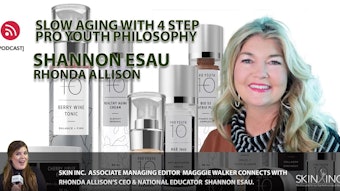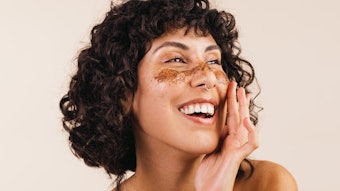
Compared with the ablative, aggressive treatment options of the past, skin inflammation is less prevalent and less severe, yet it does still occur. Plants—and the phytochemicals they contain—are an important source of raw materials specific to the recovery process.
Primary and secondary metabolites. Plants have two kinds of active constituents: Those they use to thrive and those that appear to be secondary to growth. These are known as primary and secondary metabolites, respectively. Primary metabolites include starches, amino acids, fixed oils and fats. Secondary metabolites are other plant chemicals that, only a few years ago, were thought to be useless by-products of metabolism. Researchers now know that living organisms wouldn’t produce anything superfluous. Whatever a plant’s secondary metabolites, you can be sure that they have a purpose, either for the plant directly or for the benefit of humankind. Of the 900 plants and herbs used in skin care preparations, it’s estimated that approximately 25% of them contain natural plant steroids and salicylates, compounds that have very potent anti-inflammatory properties. The versatile actions of botanicals indicate how perfectly the natural skin care products segment aligns with the 21st century medical spa.
Soothing, anti-inflammatory botanical ingredients
Using high-quality, botanically based products that are concentrated with essential fatty acids and lipids, vitamins, minerals and amino acids delivers a restorative action to the skin that complements procedures, such as microdermabrasion, as opposed to competing with them.
Whether irritation is the result of mechanical or chemical means, botanically rich products can support the skin through the inflammatory and repairing stages. Optimizing skin health involves hydrating, soothing, protecting, nourishing and rejuvenating actions, and plant extracts are active in each of these areas. As you seek out the best options to complement medical device therapies or rebalance the skin after a peel, look for products and ingredients that address all of the skin’s needs, and specifically those that control inflammation.
Arnica (Arnica montana). This has been used for medicinal purposes since the 1500s to reduce inflammation and heal wounds. Part of the sunflower family and rich in polyphenols—the pigmented parts of plants—its main constituent is thymol, a highly antiseptic component. Arnica is also very effective at neutralizing the negative energy of free radicals.
Chamomile (Matricaria recutita). Derived from the German chamomile plant Matricaria recutita, the active ingredient is alpha bisabolol, which is highly significant in anti-inflammatory and skin-healing effects. Alpha bisabolol is a viscous, colorless-to-somewhat-yellow liquid that is nontoxic and nonirritating to the skin, and is also known for its antimycotic, antiviral and antibacterial effects.
One study noted in the book Cosmetic Dermatology Products and Procedures (Wiley-Blackwell, 2010), edited by Zoe Diana Draelos, MD, demonstrated that alfa bisabolol has an anti-inflammatory effect in the skin equal to that of 0.25% hydrocortisone. Because of this, it can also sedate the inflammation associated with acne.
Candeia oil (αlpha biosbolol). The medicinal properties of alpha bisabolol are also richly concentrated within the essential oil of candeia. Candeia oil is produced by steam distilling Vanillosmopsis erythropappa, a tree from the Asteraceae family that grows in the southeast and midwest regions of Brazil. Candeia oil is used in many beauty and skin care formulas for its
soothing, anti-irritating, wound-healing, antibacterial and deodorizing properties. It is also a safe penetration-enhancer for dermal and transdermal therapeutics.
Oat extract (Avena satvia). Minor skin reactions can also be quieted with oat extract, which has been approved by German Commission E, a governmental regulatory agency, for the treatment of inflamed skin. The active constituents include polysaccharides, such as beta glucan, steroid saponins, flavonoids and polyphenols. Oat is considered a versatile skin care herb for its anti-inflammatory, antioxidant and UVA-blocking capacity.
Anti-aging botanical ingredients
Today’s spa-goers are better educated and seek out reliable anti-aging products to keep their skin young and vibrant.
Hibiscus flower. Lightweight serums that are concentrated in natural hibiscus flower peptides boost the skin’s natural reconstruction process by acting on fibroblast growth factor 2 (FGF-2). Growth factors are regulatory proteins that mediate signaling pathways between and within cells. FGF-2 is found in DNA, promotes cellular renewal and the proliferation of fibroblasts, the cells responsible for the collagen type III and glycosaminoglycan’s synthesis.
A tissue-friendly extract processed from the seeds of the flower, hibiscus peptides help firm and redensify the skin and its contours. Additionally, products rich in hibiscus extract are the perfect complement to the microcurrent, galvanic current, radio frequency and microneedling protocols.
Preserving the skin’s matrix
Matrix metalloproteinases (MMPs) are present throughout the entire body. They are responsible for breaking down worn out proteins and facilitating a second phase of wound-healing, essentially clearing the pathways so immune cells can act.
Skin aging is like a chronic wound that does not completely heal. The thinning and fragility of elderly skin is the result of an imbalance of degradation from MMPs and regeneration. In healthy or younger skin, the neosynthesis process and degradation of the matrix are in balance.
Boswellia serratta. To counter the devastating effects off MMPs, look for products rich in boswellia serratta, a resin from a tree that only grows in India. Rich in bosewellic acids, this extract controls the effects of elastase and MMPs, helping prevent the enzymatic degradation of the skin’s essential proteins and hyaluronic acid.
Pycnogenol extract. This is from the bark of the French maritime pine tree. It contains phenolic compounds, including ferulic, caffeic and coumaric acids. This herbal extract produces an anti-inflammatory effect that comes from the presence of long-chain starches known as polysaccharides. Pycnogenol also produces an antioxidant effect by recycling ascorbic acid and tochopherol. It helps reduce UVB photosensitivity and sunburn, stimulate wound-healing and balance the tissue-thinning effects of MMPs.
Lupine. This white bean is from the legume family and can now be found in skin care preparations intended to preserve skin thickness. The peptide-rich extract protects the skin’s structural fibers, particularly collagen fibers, by suppressing the damaging effects of collagenase.
Because of their ability to conserve skin structures, boswellia serrarta-, pycnogenol- and lupine bean extract-rich products are all excellent ingredients to incorporate into anti-aging protocols.
Ultra-hydrating botanical ingredients
When the skin is well-hydrated, it’s visibly smoother, unblemished and glowing.
Dehydrated skin causes cells to shrink and lose their volume. This affects the large majority of the population, making dehydration an insidious precursor to the overall aging process. Due to the amount of mechanical and chemical exfoliation happening at medical spas, the prevalence of dehydration is even greater.
Aloe vera. From the genus aloe, this is a succulent, stemless plant with plump, fleshy leaves. The leave’s rosettes are processed to produce a hydrating gel that is rich in amino acids that gently stimulate the cell-renewal process. It contains more than 70 nutrients, including vitamins and minerals, and has exceptional properties by virtue of its genetic structure. Aloe is very high in B vitamins, which help to renew the skin’s resistance and strength, and sustain it during times of stress.
In addition to the antibacterial and antifungal properties of the gel, glycoproteins and salicylates found in aloe vera gel have powerful anti-inflammatory abilities to aid with the skin’s healing process. The gel also supports the formation of collagen, which provides strength and structure to skin.
Imperata cylindrica. An intense and long-lasting hydrating action is achievable using products containing Imperata cylindrica, a subtropical plant that originates from Asia or Australia. Imperata cylindrica is a type of grass called Saccharum cylindrcum, which belongs to the common saccharum family (sugar cane). The root of the plant contains starches and sugars rich in potassium and dimethylsulfoniopropionate (DMSP), and operates as a water sensor.
In skin care, Imperata cylindrica is best known for its unique hygroscopic feature, making it capable of trapping water in the cells and slowly releasing it over time. The results if an independent lab test performed in vivo on a product containing Imperata cylindrica resulted in more than 96% hydration eight hours after application.
The action of this extract is enhanced when it’s paired with hyaluronic acid, a super humectant that formulators are now using in both heavy and light molecular weights. The tissue-friendly characteristic of the hyaluronic acid light improves hydration levels at the deepest layers, helping skin maintain its balance and resistance. The heavier molecular weight controls transepidermal water loss (TEWL), so there are multiple benefits when the two weights work in tandem.
A journey of rediscovery
As the research and momentum for therapeutic plant species grows, science and the wellness industry are now turning full circle in a journey of rediscovery for botanical skin care products.
GENERAL REFERENCES
J Bensouilah and P Buck, Aromadermatology: Aromatherapy in the Treatment and Care of Common Skin Conditions, Radcliffe Publishing, Milton Keynes, UK, (2006)
ZD Draelos, Cosmetic Dermatology Products & Procedures, Wiley-Blackwell Publishing, Hoboken, NJ (2010)
PT Pugliese, Advanced Professional Skin Care, Medical Edition, The Topical Agent, LLC (2005)
umm.edu/health/medical/altmed/herb/arnica#ixzz2bxNj2Lve
(Accessed Aug 30, 2013)











